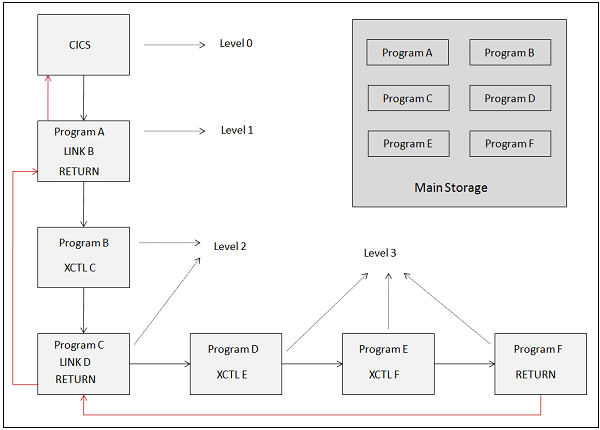
- CICS Tutorial
- CICS - Home
- CICS - Overview
- CICS - Environment
- CICS - Basic Terms
- CICS - Nucleus
- CICS - Transactions
- CICS - COBOL Basics
- CICS - BMS
- CICS - MAP
- CICS - Interface Block
- CICS - Pseudo Programming
- CICS - Aid Keys
- CICS - File Handling
- CICS - Error Handling
- CICS - Control Operations
- CICS - Temporary Storage
- CICS - Intercommunication
- CICS - Status Codes
- CICS - Interview Questions
- CICS Useful Resources
- CICS - Quick Guide
- CICS - Useful Resources
- CICS - Discussion
CICS - Control Operations
CICS Program Control Program (PCP) manages the flow of application programs. All the application programs must have an entry in the Processing Program Table. Following are the commands which are used for program control services −
- XCTL
- Link
- Load
- Release
- Return
Program Logical Levels
The application programs which execute under CICS have various logical levels. The first program which receives the control directly is at highest logical level, i.e., Level 1. The Linked program is at the next logical level from the linking program. The XCTL programs run at the same level. It will be clear when we will go through Link and XCTL, later in this module. The following image shows the logical levels −

XCTL
The fundamental explanation of XCTL is as follows −
XCTL command is used to pass the control from one program to another at the same level.
It does not expect the control back.
It is similar to GO TO statement.
An XCTL program can be a pseudo-conversational.
Example
The following example shows how to use XCTL command to pass the control to another program −
IDENTIFICATION DIVISION.
PROGRAM-ID. PROG1.
WORKING-STORAGE SECTION.
01 WS-COMMAREA PIC X(100).
PROCEDURE DIVISION.
EXEC CICS XCTL
PROGRAM ('PROG2')
COMMAREA (WS-COMMAREA)
LENGTH (100)
END-EXEC.
This command transfers the control to be passed to program 'PROG2' with 100 bytes of data. COMMAREA is an optional parameter and is the name of the area containing the data to be passed or the area to which results are to be returned.
Link
Link command is used to transfer the control to another program at lower level. It expects the control back. A Linked program cannot be pseudo-conversational.
Example
The following example shows how to use Link command to pass the control to another program −
IDENTIFICATION DIVISION.
PROGRAM-ID. PROG1.
WORKING-STORAGE SECTION.
01 WS-COMMAREA PIC X(100).
PROCEDURE DIVISION.
EXEC CICS LINK
PROGRAM ('PROG2')
COMMAREA (WS-COMMAREA)
LENGTH (100)
END-EXEC.
Load
Load command is used to load a program or a table. Following is the syntax of Load command −
EXEC CICS LOAD
PROGRAM ('name')
END-EXEC.
Release
Release command is used to release a program or a table. Following is the syntax of Release command −
EXEC CICS RELEASE
PROGRAM ('name')
END-EXEC.
Return
Return command is used to return the control to the next higher logical level. Following is the syntax of Return command −
EXEC CICS RETURN
PROGRAM ('name')
COMMAREA (data-value)
LENGTH (data-value)
END-EXEC.
Interval Control Operations
The interval control operations are of the following two types −
ASKTIME
ASKTIME is used to request for current time and date or timestamp. We then move this value to the working storage variable inside the program. Following is the syntax of ASKTIME command −
EXEC CICS ASKTIME [ABSTIME(WS-TIMESTAMP)] END-EXEC.
FORMATTIME
FORMATTIME formats the timestamp into the required format based on the options, which can be YYDDD, YYMMDD, or YYDDMM for date. DATESEP indicates the separator for the DATE as does the TIMESEP variable for TIME. Following is the syntax of FORMATTIME command −
EXEC CICS FORMATTIME ABSTIME(WS-TIMESTAMP) [YYDDD(WS-DATE)] [YYMMDD(WS-DATE)] [YYDDMM(WS-DATE)] [DATESEP(WS-DATE-SEP)] [TIME(WS-TIME)] [TIMESEP(WS-TIME-SEP)] END-EXEC.